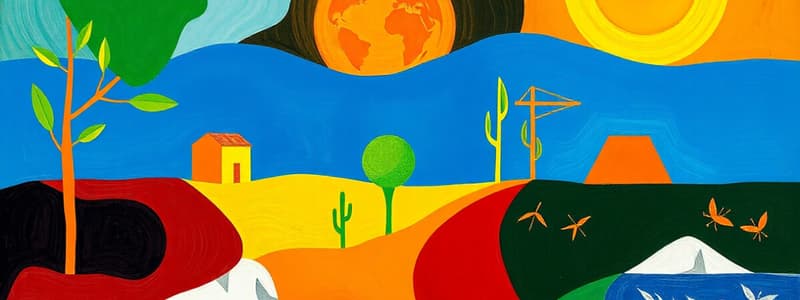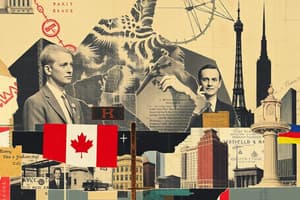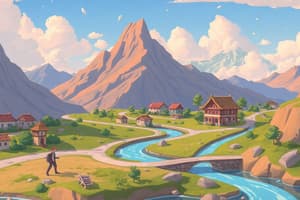Podcast
Questions and Answers
In the circular flow of income and spending, what is the primary role of the financial sector?
In the circular flow of income and spending, what is the primary role of the financial sector?
- Directly producing goods and services for the economy.
- Controlling government spending and taxation policies.
- Functioning as a spending entity within the economy.
- Acting as an intermediary between savers and investors. (correct)
Which of the following best describes 'leakage' in the context of the circular flow of income and spending?
Which of the following best describes 'leakage' in the context of the circular flow of income and spending?
- The introduction of new spending, such as government investment.
- The flow of money from firms to households as wages and salaries.
- Income or spending that exits the circular flow, reducing economic activity. (correct)
- The total value of goods and services produced within an economy.
In the context of factors of production, what differentiates 'capital' from 'money'?
In the context of factors of production, what differentiates 'capital' from 'money'?
- Capital includes natural resources, while money represents labour.
- Capital generates rent, while money generates interest.
- Capital is used for transactions, while money is used to produce goods.
- Capital consists of manufactured resources, while money is a medium of exchange. (correct)
How does entrepreneurship contribute to the production process?
How does entrepreneurship contribute to the production process?
Which scenario best demonstrates the concept of 'injection' in the circular flow of income?
Which scenario best demonstrates the concept of 'injection' in the circular flow of income?
If a country has exports (X) of $500 million and imports (Z) of $650 million, what is the net export and its effect on the total spending?
If a country has exports (X) of $500 million and imports (Z) of $650 million, what is the net export and its effect on the total spending?
How do households primarily contribute to the factor market?
How do households primarily contribute to the factor market?
What is the likely impact of increased government taxes (T) on the circular flow of income and spending, assuming no other changes?
What is the likely impact of increased government taxes (T) on the circular flow of income and spending, assuming no other changes?
In the circular flow model, which of the following transactions occurs in the goods market?
In the circular flow model, which of the following transactions occurs in the goods market?
Which of the following is an example of 'natural resources' as a factor of production?
Which of the following is an example of 'natural resources' as a factor of production?
What is the primary role of the government in the circular flow of income and spending?
What is the primary role of the government in the circular flow of income and spending?
If total production in an economy is $10 trillion and total spending is $9 trillion, what does this imply according to the circular flow model?
If total production in an economy is $10 trillion and total spending is $9 trillion, what does this imply according to the circular flow model?
How would an increase in labor productivity (output per worker) most likely affect the circular flow of income and spending?
How would an increase in labor productivity (output per worker) most likely affect the circular flow of income and spending?
Which of the following is NOT considered a macroeconomic objective?
Which of the following is NOT considered a macroeconomic objective?
What is the relationship between total production, total income, and total spending in a simplified economy?
What is the relationship between total production, total income, and total spending in a simplified economy?
Flashcards
Production
Production
Goods or services produced.
Income
Income
Payment received for factors of production.
Spending
Spending
Spending on goods and services.
Factors of Production
Factors of Production
Signup and view all the flashcards
Natural Resources
Natural Resources
Signup and view all the flashcards
Labour
Labour
Signup and view all the flashcards
Capital
Capital
Signup and view all the flashcards
Entrepreneurship
Entrepreneurship
Signup and view all the flashcards
Rent
Rent
Signup and view all the flashcards
Salaries and Wages
Salaries and Wages
Signup and view all the flashcards
Interest
Interest
Signup and view all the flashcards
Profit
Profit
Signup and view all the flashcards
Consumer Spending
Consumer Spending
Signup and view all the flashcards
Investment
Investment
Signup and view all the flashcards
Government Spending
Government Spending
Signup and view all the flashcards
Study Notes
Introduction to Mixed Economies
- Interdependence in a mixed economy can be illustrated to improve understanding.
Production, Income, and Spending
- Spending is directed towards purchasing produced goods and services.
- Production generates income.
- Income is used to spend on goods and services.
- Total Production = Total Spending = Total Income.
- This flow is continuous and circular.
Sources of Production
- Factors of production are the resources used to produce goods and services.
Natural Resources
- These are gifts of nature, including minerals (gold, platinum, coal), oil, natural gas, marine resources and agricultural land.
- Natural resources can be exploited, so their preservation is important.
- The quality of natural resources matters; some areas have vast land with little agricultural value.
Labour
- Labour is the physical or intellectual effort of people to produce goods or services to earn income.
- The quantity of labour is the labour force, which is the number of people willing and able to work.
- The quality of labour is human capital, including the abilities, skills, knowledge and health of workers.
Capital
- Capital is manufactured resources used to produce other goods and services, such as machines, tools and buildings.
- Provision must be made for depreciation (replacing existing capital goods as they wear).
Entrepreneurship
- Entrepreneurship involves people identifying opportunities, innovating, launching new products and techniques, and taking risks.
- Entrepreneurs organize and combine factors of production.
Additional Notes
- Technology is sometimes considered a fifth factor of production.
- It can be part of capital or entrepreneurship.
- Technology is innovation that makes factors of production more effective.
- Money is not a factor of production, as it cannot produce goods and services and is only a medium of exchange.
- Production can be labour-intensive (using more human labour) or capital-intensive (using machinery).
- The choice depends on cost, quality and availability of capital and labour.
Sources of Income
- Factors of production generate income in different forms.
- Natural resources generate RENT.
- Labour generates SALARIES AND WAGES.
- Capital generates INTEREST.
- Entrepreneurship generates PROFIT.
Sources of Spending
- Spending comes from four sources: households, firms, the government and the foreign sector.
Households
- These are individuals or families making economic decisions together.
- Spending by households is called CONSUMER SPENDING (C).
- Consumer spending represents households' total spending on consumer goods or services.
- Households own most factors of production and sell them to firms in the factor market.
- Households earn income by selling factors of production
- They spend their earnings on goods and services in the goods market.
Firms
- Firms buy factors of production in the factor market to produce goods and services.
- Firms sell these goods and services in the goods market.
- Firm spending is called INVESTMENT (I), which involves buying capital to produce goods or services and maximize profit.
Government
- The government's primary goal is to establish a framework for the economy to function.
- The government includes local, regional and national entities.
- The government buys goods and services from firms in the goods market.
- The government also buys factors of production from households in the factor market.
- Public goods and services such as defence, education and infrastructure are supplied by the government.
- GOVERNMENT SPENDING (G) represents government expenditure on public goods and services.
- Government income is generated from taxes (T) paid by households and firms.
Foreign Sector
- This involves the flow of goods and services between the home country and abroad.
- eXport (X) is when the home country's goods and services are sold to the rest of the world.
- Money paid by foreigners for exported goods and services enters the home country (PLUS).
- The goods and services flow out of the country.
- Import (Z) is when foreign goods and services are bought from the rest of the world.
- Money paid for foreign goods and services flows out of the home country (MINUS).
- The goods and services enter the country.
- Net export = eXport - Import (X-Z).
- The different flows between South Africa and the rest of the world are recorded in the BALANCE OF PAYMENTS.
Total Spending
- This is the sum of consumer expenditure by households (C).
- It includes investment spending by firms (I).
- It factors in government spending (G).
- Total spending considers spending by the foreign sector (net export = export (X) – import (Z)).
- TOTAL SPENDING = C + I + G + X - Z
Putting Things Together: A Simple Diagram
- Production is generated by factors of production.
- Natural resources, labour, capital and entrepreneurship are the factors.
- These factors earn income in the form of rent, salaries, wages, interest and profit.
- Spending is done by households, firms, the government and the foreign sector.
- The flows of goods, services, production factors, income and spending all move in opposite directions.
Illustrating Interdependence: Circular Flows
- Government purchases production factors (mainly labour) from households in the factor market
- Government buys goods from firms in the goods market.
- The government provides public goods and services to households and firms.
- Government spending (G) is financed by taxes (T) paid by households and firms.
- INJECTION (addition) occurs when income or spending is added to the circular flow.
- Injection from government = G
- LEAKAGE (withdrawal) happens when spending or income is withdrawn from the circular flow.
- Leakage from government taxes = T on households and firms
Adding the Foreign Sector
- eXport (X) involves the flow of money into the country.
- Import (Z) involves the flow of money out of the country.
- INJECTION from the foreign sector = X
- LEAKAGE from the foreign sector = Z
Financial Institutions
- Households and firms save a portion of their income.
- Saving (S) flows to the financial sector.
- This sector then lends funds to firms for investment spending (I).
- Financial institutions provide financial services to firms and individuals.
- This includes banks, insurance companies, pension funds and the stock exchange.
- Financial institutions are the link between surplus units (households and firms) and deficit units that need funds.
- INJECTION from the financial sector = I
- LEAKAGE from the financial sector = S
The Overall Picture
- This summarizes the circular flow diagrams.
- The basic flow occurs between households and firms.
- Consumption expenditure (C) represents the basic flow.
- Investment spending (I), government spending (G) and exports (X) are all INJECTIONS into the circular flow.
- Saving (S), taxes (T) and imports (Z) are all LEAKAGES from the circular flow.
- Total spending = total income = total production = GDP = C + I + G + X - Z
Further Key Concepts
- Specialisation
- Opportunity cost
- Absolute advantage
- Comparative advantage
Macroeconomic Objectives
- Economic growth (% change in GDP).
- Full employment (or low unemployment).
- Price stability (or low inflation).
- Balance of payments stability (or external stability).
- Socially acceptable distribution of income.
Studying That Suits You
Use AI to generate personalized quizzes and flashcards to suit your learning preferences.




